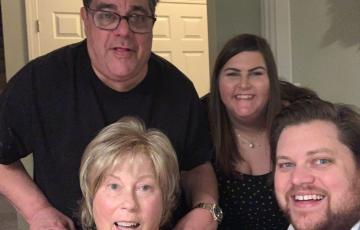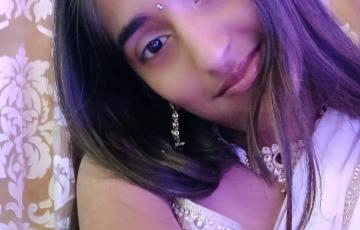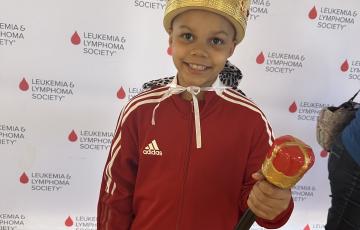Search Results

Reese
Before we knew the world of childhood leukemia, and long before bone marrow transplant was a part of our vocabulary, we had sweet little identical twin girls, named Reese and Quinn. The twins were born in Chicago on April 10, 2014. Reese and Quinn were healthy babies who grew into healthy toddlers and then their little sister Claire joined our world in 2016. These sisters are the best of friends and the greatest supporters of each other.

Samuel
On June 21, 2019, my sweet, goofy, little boy, Samuel, turned 3 years old, and we had a big celebration. We threw Samuel a beautiful birthday party surrounded by family and friends at a local farm. The kids played, fed the farm animals, went on pony and tractor rides, and ate pizza and cake. It was a day Samuel still remembers and talks about. He has always been so bright, even as a baby, saying words like “tickle” at 10 months old.
Immunotherapy
Immunotherapy is a drug therapy that stimulates the immune system. Interferon, a type of immunotherapy, is a substance made naturally by the immune system, but it can also be made in the laboratory. Interferon reduces the growth and division of cancer cells.

Lindsay
Hello, my name is Lindsay. I was recently diagnosed with chronic myeloid leukemia (CML).
Among being diagnosed with this my husband and I have been going through infertility as well. It is helpful to connect with others going through the same process that we are.
God bless!

Sahara
In August 2021, I was diagnosed with stage IV Hodgkin lymphoma (HL). I am now cancer-free. The Leukemia & Lymphoma Society (LLS) helped me tremendously throughout my process. I had the privilege of raising money for LLS through an Instagram campaign by sharing my story online.

Gina
In 1994, at the age of 29 I was diagnosed with stage IV acute myelogenous leukemia. I was told there was a five percent chance that I would survive. Having a husband and three kids, I was devastated!
I never thought this could happen to me, and it was a long hard fight, but I did it.
I survived and I feel proud to say I am a survivor!

Selina
My story starts when I was just eight months old. In March of 1994, it was discovered that I had a cheek tumor. Doctors removed the tumor, and I was treated with chemotherapy. I relapsed at two years old in 1995. I was diagnosed with acute myeloid leukemia (AML). Leukemic lesions had spread to my brain. I received intense chemotherapy and 14 days of cranial irradiation. I was very lucky that my little sister was born in June of 1995. Doctors had saved her umbilical cord (her stem cells). I underwent more chemotherapy and a stem cell transplant in October 1995.

Geoffrey
My wife was diagnosed with acute lymphoblastic leukemia (ALL) in November 2014. She went through a three-year protocol of a steroid regimen followed by one year of oral chemotherapy. She was pronounced in remission after one segment of chemotherapy but went through the entire protocol. Living in Chicago at the time, she was treated at Northwestern under Dr. Diner, a specialist in her type of ALL. Then in 2020, we moved to North Carolina and were referred to Dr. Kataryna Jamieson at UNC Hospital for what we thought would be a yearly or biannual checkup. In July of 2020, Dr.

Alexandra
My dad was diagnosed with leukemia this past fall. Our family was left in utter shock as my dad was the epitome of health his whole life. From our yearly ski trips, hiking and biking excursions, and running four marathons (motivating me to run my first with him), there was nothing he couldn’t do. He still continues to be the strongest man I know five months into his battle. He continues to face every day with a smile on his face and his head held high.
Gail
I have large granular lymphocytic leukemia (LGL), 12 years in remission. I wanted to share this poem I wrote as a message of hope for those who may be suffering with leukemia.
My Blessing!
This is my season to get my blessing! This blessing took a long time in coming. There were
so many obstacles standing in my way, but I conquered them. So many mountains in front of me that I could not climb and it
made me feel like I could not go any further, but I was able to climb them and look at me now.
Marty
My story is very unique. Christine and I got married in July of 1979. In August she was diagnosed with acute lymphoblastic leukemia (ALL). As we all now know, the prognosis at that time was not the best for an adult with ALL. There was a new procedure called a bone marrow transplant. Chris was not a candidate and seven months after we were married, she passed away at the age of 26.

Zulay
In July 2020, just four weeks away from Zulay’s 4th birthday, she became sick with a fever, bruises, and weakness. We made a trip to Cook Children’s in Fort Worth, Texas. After about two hours, the doctor came back with the news no parent ever wants to hear. She said, “I’m sorry, Zulay has acute lymphoblastic leukemia (ALL). Zulay was then admitted to the ICU.

Stephanie
Ever since I saw my dad run the New York City Marathon in 2019, I knew it was something that I wanted to strive toward. When the pandemic hit in 2020, I put that dream on pause to start a full-time job as a clinical research coordinator for bone marrow transplants.
Quade
Quade “Q” Marks is a 14-year-old freshman at East High School in Denver, Colorado. He loves to play lacrosse, ski, snowboard and aspires to be a trauma surgeon. He is also a blood cancer survivor.

Lauren
In the fall of 2022, my cousin lost her battle with leukemia. She was the most lovely (a word that makes me think of her) and kind person, and at the memorial service, Kate's sister said Kate had said, "There is nothing better than to be young and to run." This sentiment stuck with me for a long time as I am also a runner, and I started thinking about how I could honor her in my own way. The family had directed those who wished to donate to The Leukemia & Lymphoma Society (LLS), so I researched and discovered Team In Training (TNT).

Georgia
On August 18, 2021, after months of complaining about severe knee pain, I was diagnosed with mixed phenotype acute leukemia (MPAL). I was 16 at the time of my diagnosis and was supposed to be starting my junior year of high school that same day. (It was the first time everyone went back to school since COVID). The diagnosis was unexpected, and I started treatment right away at Children’s Hospital Los Angeles. Since COVID was still around, I was unable to see anybody other than my parents. It was a very scary, lonely time.

Emilee
In 2021, at the age of 19, I was diagnosed with acute myeloid leukemia (AML). I received three rounds of aggressive chemotherapy before having a bone marrow transplant at Stanford. From that point on, I have stayed in remission with no evidence of disease. I am now 21 years old, and a full-time student with three jobs!

Michael
I was diagnosed with acute myeloid leukemia (AML) on October 4, 2009. I received a bone marrow transplant from a younger brother. My late wife was originally diagnosed with breast cancer in 2015. She died of metastatic breast and brain cancer on July 18, 2018. We were each other’s primary caregivers.
Targeted Therapy
Targeted therapy is a type of treatment that uses drugs or other substances to identify and attack specific types of cancer cells with less harm to normal cells. Not all cancers have the same targets. Each type of targeted therapy works a little bit differently, but they all interfere with the growth and survival of cancer cells. To find the most effective treatment, your doctor may run tests to identify the genes, proteins and other factors in your cancer cells. This helps the doctor choose the most effective treatment for you based on the specific factors of your disease.
Stem Cell Transplantation
For some high-risk patients who are in remission, the doctor may recommend stem cell transplantation during the consolidation phase of chemotherapy.
Signs and Symptoms
It is common for children with AML to feel a loss of well-being because of the underproduction of normal bone marrow cells.
Symptoms of a low red blood cell count (called “anemia”) include the following:
- Fatigue
- Weakness
- Shortness of breath during normal physical activities
- Lightheadedness, dizziness or faintness
- Headaches
- Pale complexion
Symptoms of a low white blood cell count (called “neutropenia”) include the following:
Relapsed and Refractory
Relapsed CLL is the term for disease that returns after it has been in remission for more than six months.
Refractory disease is the term for CLL that does not result in remission after initial therapy.

Krisha
I’m always open for an opportunity to dedicate my time and efforts in assisting those in need. I am on a mission to provide support and comfort to individuals who are battling leukemia and lymphoma. This is in honor of my relatives who have lost their lives to cancer. I am extremely happy to be able to be part of a cause that helps other survive and thrive.

Luis
I was diagnosed with chronic myeloid leukemia (CML) in 2008. I immediately started my chemo treatment in pill form which is Gleevec® 400 mg. I was in treatment for seven years until 2015, and I completely stopped all treatments. I have been cancer-free for the past nine years. I want to share my story and experiences with others.

Aiden
I am writing to share about my son, Aiden, who is our real superhero and has superpowers that shine bright through his love of dance. From a very young age, we considered Aiden to be our gifted child. He has a free spirit and loves to connect with the world and others in it. His parents have taught him to "dream big" and "reach for the stars" and he can do whatever he puts his mind to.